- Home
- Simon Kernick
The Bone Field Page 8
The Bone Field Read online
Page 8
The channel was too wide to jump across and the water looked deep so I kept walking until eventually it came to a halt and the boundary was replaced by a high hedge.
I stopped. There was a gap a couple of metres wide between the spot where the channel ended and the hedge began, and someone had put in a fence topped with barbed wire to prevent anyone getting through. The fence looked new and it was clear that at one time this had been an access point between the two properties. Up ahead I could see the maintenance block fifteen metres away, where the old road ended. I tried to picture the scene of the killers arriving in their car with Dana Brennan. I hoped that by then she was dead, but I had a horrible feeling that she was still alive.
Being led to her death.
I imagined a warm summer’s night, and the killers taking her past where I was standing now.
The thought made me shudder.
I wasn’t going to get past the fence. It was designed to keep out bored schoolboys and the way it splayed out at an angle over the end of the channel meant there was no way round or over.
I could of course simply have driven round next door, found the estate manager myself, and got him to take me down to the folly, but that seemed like a lot of hassle.
I’m pretty tall at six feet two, and back at school I’d been in the athletics team. I wasn’t the greatest long jumper in the world, I wasn’t even the greatest in my year, but I reckoned I had a chance of leaping the channel. So that’s what I did. Ignoring the fact that I was dressed in my favourite suit and the kind of shoes you turn up to official functions in, I took a ten-metre run-up and leaped into the air.
I hit the bank on the other side, winding myself in the process, and just managed to get my arms over the top to stop myself falling back into the water. Even so, I got my shoes wet and had to half clamber, half roll up until I was able to get to my feet on the other side. I brushed the dirt off my jacket and shirt and clambered through the undergrowth in the direction of the folly, hoping there weren’t any cameras installed round here otherwise I’d have a lot of explaining to do.
The woodland was darker and more overgrown than it was on the school side, and it took me a few minutes of hunting around before eventually the folly loomed up at me out of the gloom, a dome-shaped building made of flint and stone covered in snake-like ropes of ivy and encroaching tree branches that looked like some ancient ruin. A faded, partially covered carving of a snarling gargoyle’s head glared down at me from just above the folly’s single arched entrance, as if warning intruders to stay away.
I ignored the gargoyle’s warning and stepped inside.
The interior of the folly was a single round room about five metres square with a floor made out of a mosaic of cracked tiles. It was almost pitch black inside and smelled musty and old. There was something unpleasant about it too. An oppressive, airless atmosphere, as if all life had been sucked out of the place.
I hadn’t brought a torch with me so I pulled out my mobile, found the torch app and turned it on, partially dispelling the gloom. I looked up and saw the ceiling disappearing up into the hollowed-out dome amid a cluster of cobwebs, plaster dust and tendrils of browning ivy. A fat black spider sat in the middle of one of the webs surrounded by half a dozen dead, cocooned flies. The spider didn’t move as my light ran across it, taking in the rest of this empty chamber.
And that was when I saw it. A sign scratched into the brickwork at head height, probably by a knife. It was the size of a large dinner plate and, though faded with age and partly obscured by dust, it was still possible to see that it was of a pentacle with the letter ‘M’ carved inside in a high, narrow font, with the legs of the letter curling at the bottom.
I flicked through the photos on my phone until I came to the one of Henry Forbes’s partially burned tattoo, the tattoo his killers had tried to get rid of. I put the phone up against the carving on the wall. The patterns on both seemed identical. They were the same signs.
I smiled. I had a lead.
Twelve
The Dark Man watched through binoculars from the other side of the valley as Charlotte Curtis buried the dog in her garden.
Even from this distance he could see the pain in her expression, and the wetness on her face from the tears. But he didn’t want to see pain. He wanted to see fear. It was essential that this woman was too scared to say anything to anyone. In many ways it would have been safer simply to kill her, and The Dark Man had discussed this possibility with his boss several times this past week. In the end they’d decided against it on the basis that it might arouse too much suspicion. Looking at the woman now, though, The Dark Man wasn’t entirely convinced that leaving her alive was such a good idea. It was something he needed to consider further.
He breathed in the warm country air, enjoying the anonymous embrace of the trees. The Dark Man loved forests. They reminded him of a long-ago childhood far away from here, and of freedom. He always felt safe when he was among trees. Here, he was part of a much older, more natural world. The Dark Man hated people. He always had. He longed for a world where they were gone altogether, where there was just him left, free to walk alone through the mountains and forests, never to be bothered by anyone again. He gained no joy from money, nor luxury goods. He had never married, nor been with a woman for anything other than basic needs. Those few who knew him thought him cold and humourless, but in that they were wrong. His heart was full of rage and darkness. He had only two true pleasures in life. One was the forest at night. The other was killing.
The Dark Man had been only twelve years old when he committed his first murder. Since then, he’d killed many times. Sometimes it had been for business. Other times it had been for enjoyment. Every one had been pleasurable, although the slower kills when the victims’ screams filled the room and he could properly breathe in their pain were by far the most satisfying. He could still remember the faces of every one of his victims, and often at night they would come to him in dreams and he would kill them all over again – young, old, male, female. They were his conquests. His trophies.
The Dark Man smiled to himself, looked back through the binoculars as Charlotte Curtis walked slowly across her patio, the dirt-covered shovel in her hand, and wondered if she too would become another of his trophies.
Thirteen
Ealing cop shop, my current place of work, is a prime example of everything that’s wrong with 1970s architecture. A grim five-storey structure done out in competing shades of drab, it stands out like a cheap Soviet-era hostel between two much flashier buildings on the Uxbridge Road, and after spending time in the bucolic setting of Medmenham College, the sight of it at six p.m. in the middle of a typical west London rush hour didn’t exactly fill my heart with joy.
The incident room was heaving when I walked in. As well as the rest of the team, there were a dozen or so civilian staff taking up all the available desk space. No one took any notice of my arrival. They were all too busy beavering away on their PCs, and the place was as silent as a library.
I went over to where DC Julia ‘Jools’ Hutchings was working at the desk next to mine, in the corner by the window. Jools was one of the few members of the team who actually seemed to like me, and I think that was mainly down to the fact that I’d given her £300 sponsorship money to run the London Marathon on behalf of a breast cancer charity. Still, you take what you can get, and I liked her too. I also felt strangely protective of her. She was a petite little thing, barely five feet four, who looked a lot younger than her thirty-two years. She was also a happily married mum of two sons under five who kept photos of her family all over her desk, and I often wondered why she did such a stressful, unsociable and frequently unpleasant job when there were a million other things she could be doing. I never said any of that to her, though. She’d have killed me.
Before I’d left to see the Brennans earlier, I’d given Jools a whole heap of research to do, so I pulled up a chair and asked how she’d got on.
‘Right,’ she said, stretch
ing in her seat. ‘I’ve been through both case files, and there’s nothing that stands out. Obviously the Kitty Sinn file’s a lot thinner because the Thai police were in charge of the investigation. But Sussex police did send two detectives to Thailand at the invitation of the authorities there ten days after Kitty went missing, and they interviewed Henry Forbes, the guesthouse owner who was the last to see Kitty alive, and a few of the guests at the places she and Henry stayed. According to the file, nothing they found contradicted Forbes’s story.’
‘Are either of those detectives still working?’
She shook her head. ‘No. The most senior of the two, DCI Greg Fairbairn, died in 2010, and his colleague, DC Roger Powell, retired in 2005. I’m trying to track him down at the moment.’
‘Thanks, Jools, I appreciate it. Anything in the Dana Brennan file?’
‘Nothing we don’t already know. There was a huge inquiry at the time that turned up nothing. No suspects. No witnesses. Then a major cold case review in 2001 with the same result. How did it go with her parents today?’
‘Tough. Finding Dana’s body brought it all back for them.’ I didn’t tell her about the promise I’d made to her parents. That was between them and me. ‘How about Henry Forbes? What have you got on him?’
‘Plenty,’ she said, picking up a piece of printed A4 paper. ‘Born in 1965. His father was a high-ranking civil servant in the Home Office; his mother comes from family money. He was brought up in London where he attended Westminster School and left with OK but not spectacular A Levels. He went to Goldsmiths, studied Politics, Philosophy and Economics, got a 2:1, and stayed on to do an MA then joined the teaching staff. In 1989 he moved to Brighton where he joined the staff at the polytechnic and, apart from a year’s break after Kitty Sinn went missing, he’s been there ever since, working for the same department, even living in the same house. He never married, never had any children, and his only long-term relationship was with a former student by the name of Roz Smith who he lived with between 1998 and 2007. He’s always received an annual allowance of £35,000 through a family trust fund so he’s never been short of money. No criminal record and, aside from the Kitty Sinn case, it doesn’t look like he’s been involved in anything remotely controversial.’
I sighed. ‘Great. So he didn’t have any connection with Medmenham College?’
‘I can’t find one.’
My earlier good mood at finding the carved symbol in the folly had faded now. ‘Oh well. Thanks for that.’
I started to get up but Jools leaned forward in the seat and dropped her voice to a whisper. ‘Are you going to take me along with you next time you go out for the day? Because I’m dying of boredom in here.’
I knew how she felt. The incident room at Ealing nick had all the atmosphere of a graveyard, but without the fresh air.
‘I promise,’ I said with a smile. ‘Hand on heart.’
Olaf was on the phone in his office but he waved me in when he saw me outside his door, and by the time I’d shut it behind me and sat down, he’d finished the call.
I asked him if the team had generated any leads.
He scrunched forward in his chair, elbows on the desk, his head almost disappearing into his shoulders as he stared across at me, looking less than happy. ‘Absolutely fuck all. We’ve got CCTV footage of the killers at the main gates of Reedman’s property in a black BMW X5 with their faces covered, but that’s it. They open the gates remotely somehow, probably with a cloned key, so they don’t even get out of the car. We’ve got them driving away too, but the plates on the BMW are fake, and they obviously change them nearby, because none of the ANPR cameras pick them up again.’ He sighed. ‘I’ve got a feeling finding the shooters is going to take a while. How about you? How’s your day gone?’
I gave him a brief rundown then told him what I’d learned. ‘I’m certain Henry Forbes was involved in the murder of Kitty Sinn. I don’t think he was a part of Dana’s murder, though, but I think he might have been told about it by the people who were.’
‘Why do you think other people were involved?’
‘Because that’s what Henry told me. I also think both murders were committed in the school grounds during summer holidays.’
‘There’s only one problem with that, Ray,’ said Olaf. ‘Everyone knows Kitty went missing in Thailand, and there’s no record of her leaving the country. So how did she end up back here?’
I shrugged. ‘God knows. All I do know is that somehow Kitty came back here from Thailand incognito, and that Henry and his friends killed her at some point after that.’
‘Problem with that is the timings don’t match up. Henry remained in Thailand for almost a month after Kitty went missing. There’s no way Kitty came back to the UK and stayed under the radar with all the publicity that surrounded her disappearance until Henry turned up again and killed her.’
‘Well, maybe Henry wasn’t there then, but he knew about it. Either way, I’m certain she died at the school, and that at least one of her killers was either a pupil or staff member there. I also found out something else. There’s a folly, an old ruined building, on land directly next to the school. It’s got an occult symbol on the wall inside that looks like this.’ I pulled out my phone, found the photo I’d taken, and showed it to Olaf.
He didn’t look particularly impressed.
‘I’m guessing you don’t recognize it?’
‘You’re guessing right, Ray.’
I scrolled through the photos until I came to the one of the tattoo on Henry Forbes’s underarm. ‘It’s called a pentacle, essentially a five-pointed star. Look at the markings on Henry’s arm, then compare them to the symbol. They’re identical. Henry’s killers definitely wanted to burn off his tattoo.’
‘Are you sure? They might just have wanted to burn down the house to get rid of evidence.’
‘Then why not set fire to the curtains? Or something that’s actually going to spread the flames? No, they set fire to Henry, because they wanted rid of that tattoo.’
Olaf gave me the kind of look usually reserved for blathering idiots. ‘Blimey, Ray, this is all a bit thin, isn’t it? You’re not telling me you think this whole thing’s down to devil worship, are you?’
‘I don’t know,’ I said. ‘But right now leads aren’t exactly flying out at me.’
‘Nor me. But I might have something for you to follow up on. The person I was just on the phone to was Tina Boyd.’
‘The Tina Boyd?’ That made me sit up. If you were looking for truly controversial figures in the Met’s recent history, there were only two who automatically sprang to mind. One was me. The other was Tina Boyd. Shot twice; kidnapped once; held hostage; involved in at least three killings that had somehow just about held up as self-defence; suspended more times than I could remember; and now a private detective, having either been jumped or been pushed out of the Met, I can’t remember which. I raised my eyebrows. ‘Really? What did she want?’
‘She was contacted by Henry Forbes last Monday, 11 April 2016. That’s the day the first remains were discovered at the school, but the day before the discovery was made public in the media. Forbes wanted Tina to find a woman he knew from the past. And he wanted it done urgently. He even paid her two grand up front to do it.’
‘Who’s the woman?’
‘Her name’s Charlotte Curtis. Tina’s got an office in Paddington. Would you mind going down there and getting all the details from her?’
‘Of course not. But why are you using me for this?’
‘I’ve got a lot of good coppers on this team, but not many good detectives. You’ll know which questions to ask.’ He winked at me. ‘Unlike some people, I trust you, Ray. That’s why I’ve been fighting your corner. Here’s her address.’ He pushed a slip of paper across the desk. ‘She’s there now. Find out what you can and let me know.’
I got up and left his office, not bothering to ask who it was who didn’t trust me. The way most of the team avoided my gaze as I walked back throu
gh the incident room gave me my answer.
Fourteen
Tina Boyd’s office was on a residential street in one of the less salubrious areas of Paddington with views towards the railway tracks and the giant A40 flyover beyond. It was just before seven and the sun was dropping off to the west as I found a parking spot about fifty metres down from her front door.
I have to admit I was intrigued to meet her. Tina Boyd was probably the most famous female police officer of her generation. Like me, she’d been involved in her fair share of famous cases and had a knack for being in the wrong (or right, I suppose) place at the wrong time. A tough yet attractive brunette with plenty of baggage, she was a survivor, and I admired that. On a dating website we’d have been a perfect match.
I pressed the buzzer, and a few seconds later she appeared behind the glass, giving me a coolly appraising look before opening the door. She was dressed in jeans and a tight-fitting white shirt with a jacket over the top. A simple look, yet there was something surprisingly elegant about the way she carried herself.
Her face broke into a welcoming smile as she put out a hand. ‘The Ray Mason. Pleased to meet you.’
‘The Tina Boyd. Pleased to meet you too.’
She was a good-looking woman of about forty, with the lean, angular face of a runner, and shoulder-length black hair. She wore her years well, but her eyes were hard, and there was a natural mistrust in them that I guessed came from seeing too much of the dark side of life, and which was probably matched by the look in mine.
She led me through a narrow hallway that smelled of cleaning products and into her office, which smelled of cigarettes. It was a small room dominated by a big desk with a chair on either side. The window behind her was open and looked out on to a car park with a rusty skip in it. It wasn’t the prettiest view I’d ever seen.

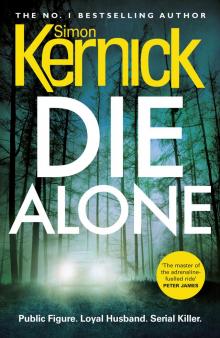 Die Alone
Die Alone Deadline
Deadline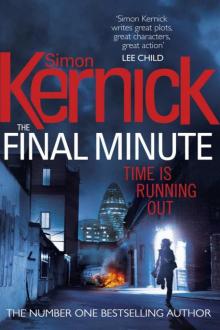 The Final Minute
The Final Minute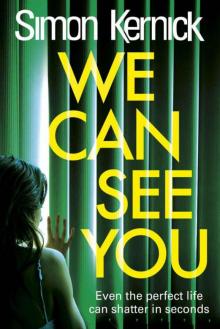 We Can See You
We Can See You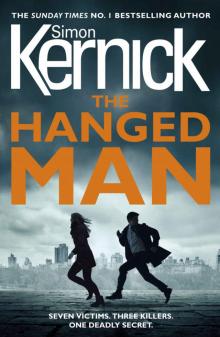 The Hanged Man (Bone Field 2)
The Hanged Man (Bone Field 2)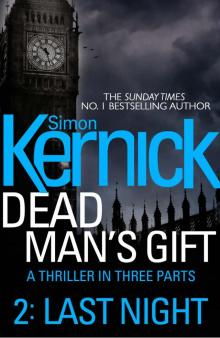 Dead Man's Gift 02 - Last Night
Dead Man's Gift 02 - Last Night Dead Man's Gift and Other Stories
Dead Man's Gift and Other Stories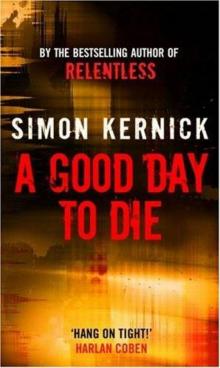 A Good Day To Die
A Good Day To Die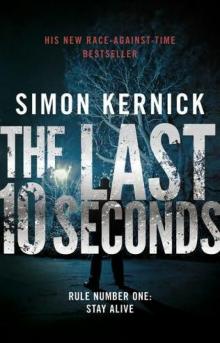 The Last 10 Seconds
The Last 10 Seconds The Murder Exchange
The Murder Exchange The Bone Field
The Bone Field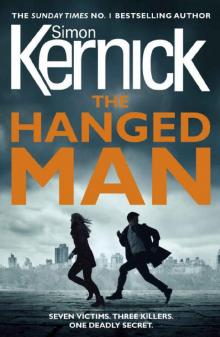 The Hanged Man
The Hanged Man Target
Target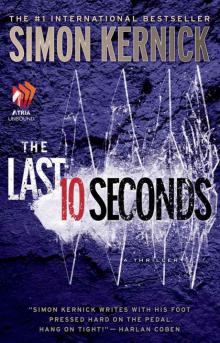 The Last 10 Seconds: A Novel
The Last 10 Seconds: A Novel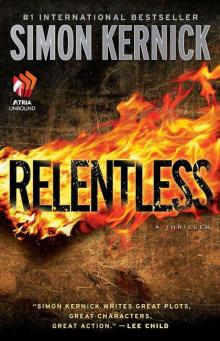 Relentless: A Novel
Relentless: A Novel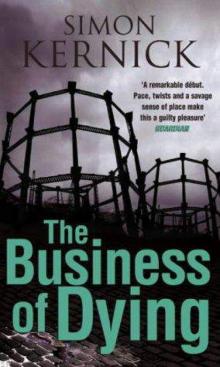 The Business Of Dying
The Business Of Dying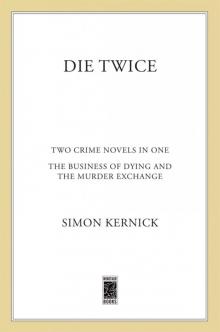 Die Twice
Die Twice Flytrap
Flytrap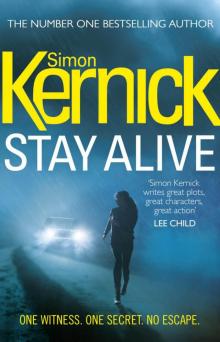 Stay Alive
Stay Alive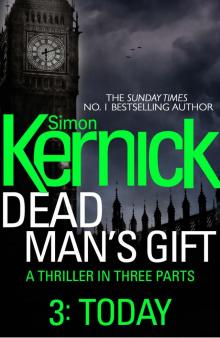 Dead Man's Gift 03 - Today
Dead Man's Gift 03 - Today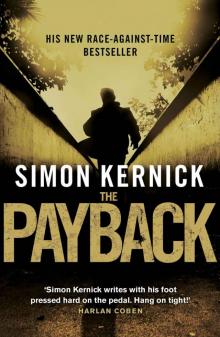 The Payback
The Payback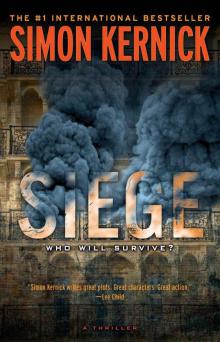 Siege: A Thriller
Siege: A Thriller The Crime Trade
The Crime Trade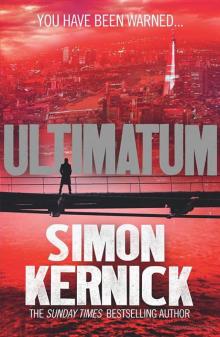 Ultimatum
Ultimatum